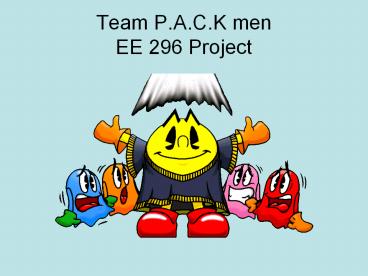Team P'A'C'K men EE 296 Project - PowerPoint PPT Presentation
Title:
Team P'A'C'K men EE 296 Project
Description:
Team P.A.C.K men. EE 296 Project. Chris Mcleod. Hardware specialist. Kyle Tanabe. Logic and programming specialist. Paul Linden. Systems specialist. Aaron Lake ... – PowerPoint PPT presentation
Number of Views:52
Avg rating:3.0/5.0
Title: Team P'A'C'K men EE 296 Project
1
Team P.A.C.K menEE 296 Project
2
Chris McleodHardware specialist
3
Kyle TanabeLogic and programming specialist
4
Paul LindenSystems specialist
5
Aaron LakePower specialist
6
P.A.C.K. Rat our hard working mouse. February 1
Breadboard Stage
7
March 1
Connection of the driver circuit. Portability
in power sources.
Many tedious connections. sodering , clipping
wires for connections.
8
Goals
- Design and Build a robot capable of finding the
center of a maze - Have the mouse be able to return back to the
center without looking for a new path.
9
By the end of March
- Complete fabrication of the sensor layout.
- Basic tracking and alignment code for traveling
down a corridor.
10
By April 5
- Have all the code up and running.
- Begin trouble shooting.
11
Breakdown of project
12
Power management
- AA Duracell NiMH rechargable batteries.
- 2.05 A/hr, 1.2V
- Processor 5V
- Motors 9.6V
- Sensors 5V
- 16 total batteries
13
Drive system
- Motors NEMA 17 stepper motors
- 9.6 VDC
- 1.8o step
- uni-polar
- Chassi single piece of 1/8 aluminum
custom fit to specifications. - Wheels custom aluminum alloy rims
- with rubber treads
- radius 2.35cm
14
Driver Circuit
15
Underneath view
16
Sensory system
- 20 infrared sensors, 4 on each corner.
- 4 middle sensors .
- Top down design.
- Symmetrically placed along board with enhanced
peeking abilities.
17
Top right corner sensor layout
18
Sensory Layout
Outer sensors
Middle sensors
19
Traveling down a corridor the inner four sensors
remain on telling the mouse that it is centered.
These sensors correct and adjust alignment and
also scout out walls in theory.
20
When the mouse reaches a possible turning point
the four outer sensors will go off.
21
When all 4 middle sensors all activated the mouse
knows to turn.
22
Logic and processing
- Rabbit 2000 microprocessor.
- Dynamic C
- Tracking based on sensory input.
- Maze flooding concept to solve maze.
23
Maze Flooding
24
Logic Modules
- Driver
- Search Mode
- Sensors
- Decision
- Movement (Left,Right,Forward,U-Turn)
- Direction
- Alignment
- Found Mode
25
Sample Algorithm
- Forward Movement
- Initialize sensor readings
- Do following until moved 1 square
- Move forward 12 steps
- After each step check sensors
- If sensors detect turn, set sensor reading as
such - Check Alignment and fix if alignment no good
- Check Alignment
- Alter array
26
Additional thoughts
- Potential problems
- design issues
- logic problems
- power issues
- What we will Learn
- Teamwork
- Engineering Applications
- C C and more C
27
Any questions?
28
Tanks for coming out!















![NOTE: To appreciate this presentation [and ensure that it is not a mess], you need Microsoft fonts: PowerPoint PPT Presentation](https://s3.amazonaws.com/images.powershow.com/6484074.th0.jpg?_=20200716105)















